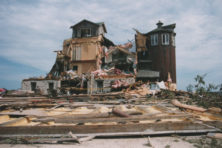Door to Nature: SOS
- Share
- Tweet
- Pin
- Share

I have noticed a female sharp-shinned hawk catching birds in my front yard since last November. I can tell she’s a “sharpie” by the squared-off end of her tail, and by her head, which is smaller than that of a Cooper’s hawk. She is also distinctive in that she has several small patches of white feathers on the back of her head, which is not normal plumage.
The international sign of distress is “SOS.” That is what I call the bird problem at my feeders during the past three months. The marvel-meal feeder is usually empty by early afternoon, but now I frequently notice that there is still food in it later in the day. Then I know that predators have been in the yard.
There are many times when the yard is totally quiet, with no birds at the feeders. Then a crowd of woodpeckers, nuthatches and chickadees will come in to get seeds and suet. When it is very quiet, I often see a single downy or hairy woodpecker standing motionless at a feeder, and it may stay that way for up to 20 minutes. That’s when I know that a hawk or shrike has been in the woods. If the birds stay completely still, the hawk does not see them. The predator is watching for movement and then rapidly zooms in for the catch.
I have also seen a northern shrike in my front yard during the past few months. This bird typically nests in far northern Canada and comes into our area during the winter. A shrike preys on smaller birds such as sparrows, juncos, chickadees and goldfinches, but I have also seen shrikes snatch a cardinal. They hunt by perching in a nearby tree and watching for any movement of their prey.
Last week I saw the sharpie catch a female hairy woodpecker. The sharpie landed on the ground just beyond the feeders and began pulling out the hairy’s feathers. When I looked with my binoculars, I could see that the hairy was still alive and squealing loudly. I went out on the deck to try to chase the hawk away, but it just lifted the woodpecker with its talons and flew into the spruce grove to the west. A day later, I saw it catch a male downy woodpecker.
Situations like these almost make me want to stop feeding. We truly enjoy seeing all the birds that come to our feeders; however, feeders are a certain lure for the hungry predators that live in the region, too. Yes, I know that all birds need to eat to survive, so I shouldn’t be too picky about which ones I’m feeding.
A northern shrike is nearly the same size as a male sharpie, with the shrike at about 10 inches and the sharpie at 11-12 inches. However, in hawks, the female is always larger, which gives her the advantage of being able to defend the nest and protect the youngsters as they grow in her care.
A female sharp-shinned hawk can be nearly the same size as a male Cooper’s hawk. Cooper’s have larger heads, thicker legs and longer tails, which are more rounded at the end and have a wider, white band at the tip. The adult Cooper’s can also have a darker crown.
Years ago, Cooper’s hawks were becoming rare, but their populations seem to be recovering. The sharp-shinned hawk is more numerous and most likely the one that snatches birds at your feeders.
There has been continued concern about bird flu and how it’s affecting our native wild birds. It was thought that once winter arrived, the colder weather would reduce the spread of the virus, but this winter has been much warmer than normal.
Numerous poultry farms across Wisconsin and in other parts of this country have been hit with the virus, which kills many chickens and other poultry. That’s one reason why commercial egg prices have gone through the roof. It plays a part in the inflation hitting our lives.
Bird flu has also affected many of the larger birds of prey, ducks and other waterfowl. Last year, the virus hit the Caspian terns in their nesting grounds and wiped out a considerable number of birds.My friends know how I enjoy a play on words, and this story can be just that. “SOS” is the signal for distress. It can also stand for “shrike or sharpie,” but in addition, it can mean that I’m “saving (money) on seeds and suet” because of the smaller number of birds at my feeders.

